There are many physiological factors which are important for success in cycling, particularly leg power and aerobic endurance. Body size also plays a part, as it is the muscular power and aerobic endurance capacity proportional to body weight (power to weight ratio) that is important.
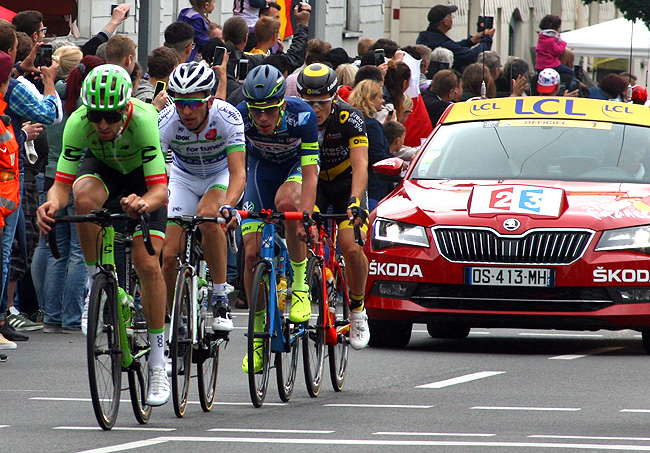 riders on the 2017 Tour de France
riders on the 2017 Tour de FranceSuccessful cyclists are generally exceedingly lean, with skinny arms and big muscular thighs. Elite cyclists have also been found to have proportionally longer femurs, which gives them extra leverage when they push the pedals. Among the road racers, the climbers tend to be lighter and smaller than the sprinters and time trialists. The Tour de France is almost always won or lost on mountain climbs, so successful riders in this event will need to fit the mold somewhere between the great climbers and time trialists.
As cyclists have become more professional over the years and training and diet more fine-tuned to maximize performance, has this been reflected in the body size of the elite cyclist? Here we look at historical anthropometrical data of the participants of the Tour de France, the premier tour event which attracts the greatest of riders from around the world, and look for trends in changes in these parameters and relate them to the performance of the cyclists.
Tour de France Cyclists Stats
There is limited historical anthropometrical data of Tour de France cyclists available, though the height and weight of all participants in recent years have been collated by the procyclingstats website, and the height and weight of many of the winners can be found online going back to at least the 1940s.
We have analyzed the age, height and weight data of all participants in the Tour de France since 1990, and the age, height and weight of the winners going back to the 1940s (up to 2019). Using these height and weight measures, we have calculated the average BMI measurement, which is a general (though somewhat flawed) measure of leanness.
Riders are Getting Older and Thinner
The general findings of our anaylysis is that the participants in the Tour de France on average have been getting older, however riders can still win at any age - case in point the 2019 winner was only 22 years old, well below the average winner's age of 28. Again in 2020 there was a young winner, Tadej Pogačar also 22 years old. The average height of riders has not varied much, though riders are much leaner than they were once, reflected in a lower weight and body mass index.
We discuss each of these parameters below in more detail. See also the original data tables.
Age of Tour de France Cyclists
The average age of all cyclists from each tour has gradually increased since it was first recorded, rising from an average of about 28 years to nearly 30 years now, shown clearly in the graph below. Such an increase in age may be due to advances in medicine, diet and training keeping the riders in top condition, but also due to the increasing monetary rewards providing the incentive for them to keep competing for longer.
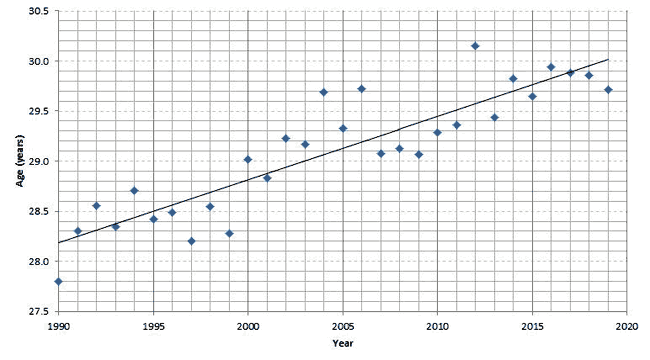
We have data about the age of the winners for all tours. This data does not show such a clear increase as does the average data, it more so demonstrates the wide variation in ages. The average age of the tour winner is 28 years, ranging from the youngest Henri Cornet winning in 1904 at only 20 years of age, the oldest Firmin Lambot winning in 1922 aged 36.
In recent years, the winners were generally above the average age, being experienced riders in their early thirties. However, the winner of the 2019 tour was only 22 years old, the youngest winner of the Tour de France since World War II. Also the 2020 and 2021 winner Tadej Pogačar was 21 and 22 years old respectively.
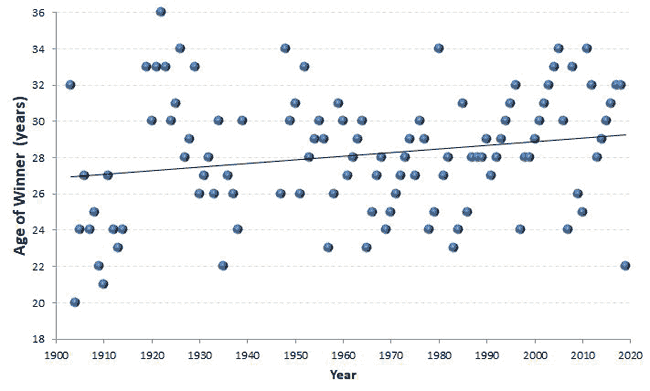
Height of Tour de France Cyclists
The average height of all cyclists from each tour since 1990 is mostly between 1.80m and 1.82m. The anomalous average height of 1.86m in 1993 skews the data, which shows otherwise a fairly consistent average height. This data was taken from that published by procyclingstats, and their database from the 1990s may not have included all the riders, so may not be as representative of the whole group as more recent averages.
The tallest rider on record is Marcel Sieberg at 1.98 meters (6' 6"), who rode in the Tour de France nine times between 2007 and 2018. The winner of the first-ever race in 1903, Maurice Garin, was only 1.62 m (5' 4"), though the shortest may be Samuel Dumoulin at 1.59 meters (5' 3") who rode in the Tour de France 12 times between 2003 and 2016.
A professional cyclist who literally stands out among his peers is Irishman Conor Dunne, who races for Aquablue. He is yet to ride in the Tour de France, but if he does you will notice his 2.04m tall frame which absolutely towers over his fellow riders.
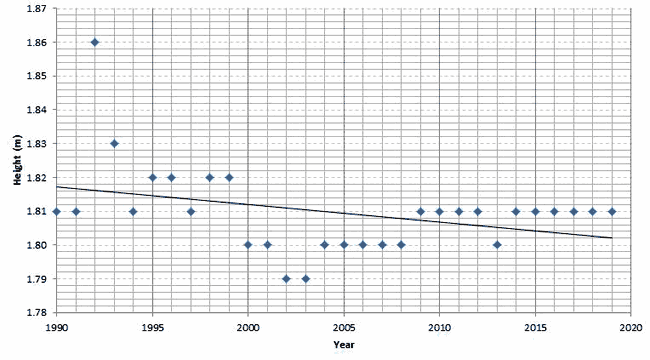
The graph below of the winner's height for each tour since 1947 shows a general trend of increasing height. The winners in the last decade have been particularly taller, above the average of the peloton - except in 2019! Egan Bernal, who was the youngest winner of the Tour de France since World War II, bucked the trend in height as well and was only 175m tall. The tallest Tour de France winner was Bradley Wiggins at 1.90m (6'3"), and there are also a few tall recent winners at 1.86m (6'1") - Chris Froome, Andy Schleck and Miguel Induráin.
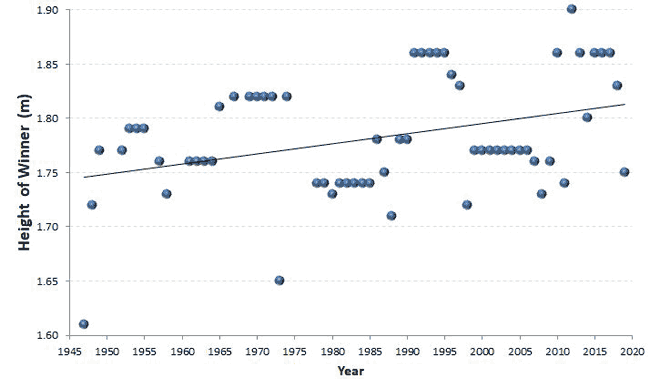
Weight of Tour de France Cyclists
Since 1990, the average weight of all cyclists in the Tour de France has decreased, though seeming to plateau in the last 10 years. There has been a drop in the average weight of about 5 kg (11lbs) over that time, with no significant difference in height - which would indicate that the riders are getting slimmer.
The heaviest rider on record is Magnus Backstedt at 95 kg (209.5 lbs). The lightest, Leonardo Piepoli at 57 kg (125.7lbs).
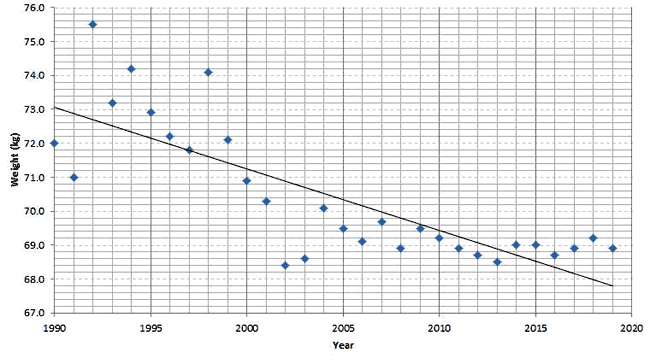
Below is the graph of the winner's body weight for each tour. Since 1945, there is great variation, though there is no trend of significant changes (unlike the decrease in average rider weight shown in the last 30 years).
The 1973 winner, Luis Ocaña, was just 52 kg (115 lbs). At the other end of the scale, Miguel Induráin was recorded at 80kg (176 lb).
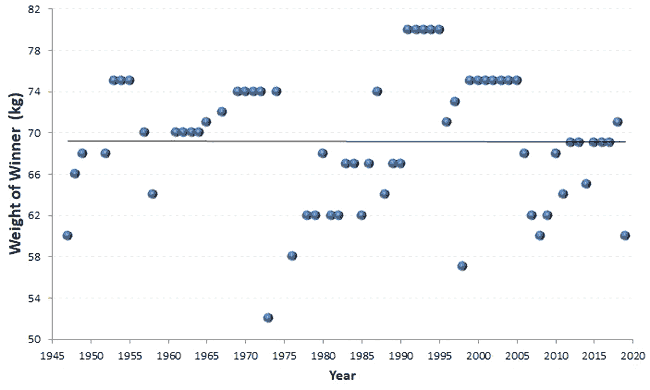
BMI of Tour de France Cyclists
As mentioned above, it is the power to weight ratio that is very important for cyclists, which is maximized by having low body fat levels. The body mass index (BMI), which relates weight to height, is a general indication of body fat levels. The graph of the average BMI of all cyclists from each tour since 1990 shows a clear decrease, a reflection of the decreasing average body weight while the height has not changed - therefore the riders are getting thinner.
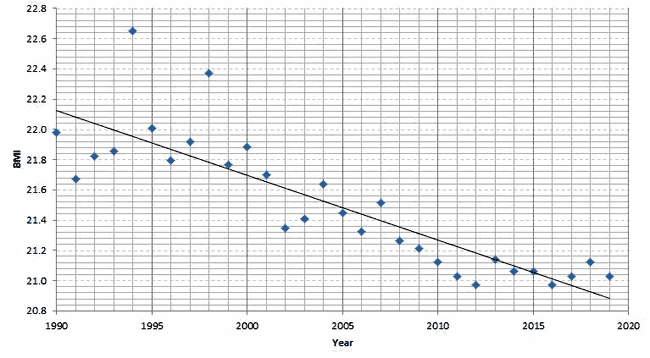
The BMI of the winners since 1947 also shows a tendency to get lower over time. The 2012 winner Bradley Wiggins had a BMI of only 19.1, as did Luis Ocaña, the winner from 1973 winner. The heights of these two riders were very different (1.90 m v 1.65 m) but obviously they both carried very little bodyfat.
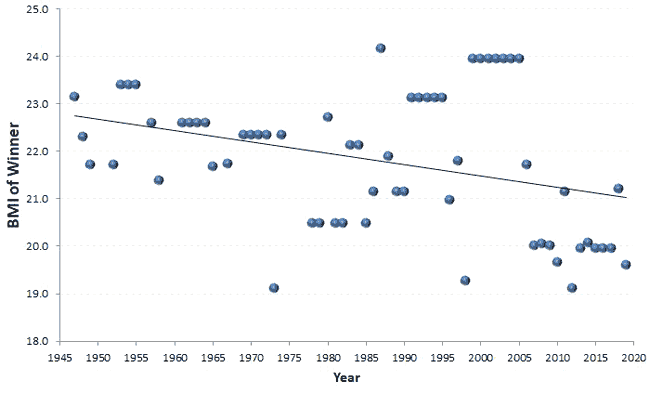
Olympic Cycling
At the 2012 Olympic Games, the averages of the road cyclists were 180.5cm and 70.8 kg, with an average BMI of 21.7.
Selected References
- Foley, J. P., Bird, S. R., & White, J. A. (1989). Anthropometric comparison of cyclists from different events. British journal of sports medicine, 23(1), 30–33.
Related Pages
- Fitness testing for cycling
- Anthropometry for cycling
- Olympic Games Anthropometry for other sports in 2012
- Athlete Body Size Changes Over Time
- All about fitness testing, including anthropometry testing
- Poll about the fitness components for cycling
- How to measure Height and Weight, and calculate BMI measurement



